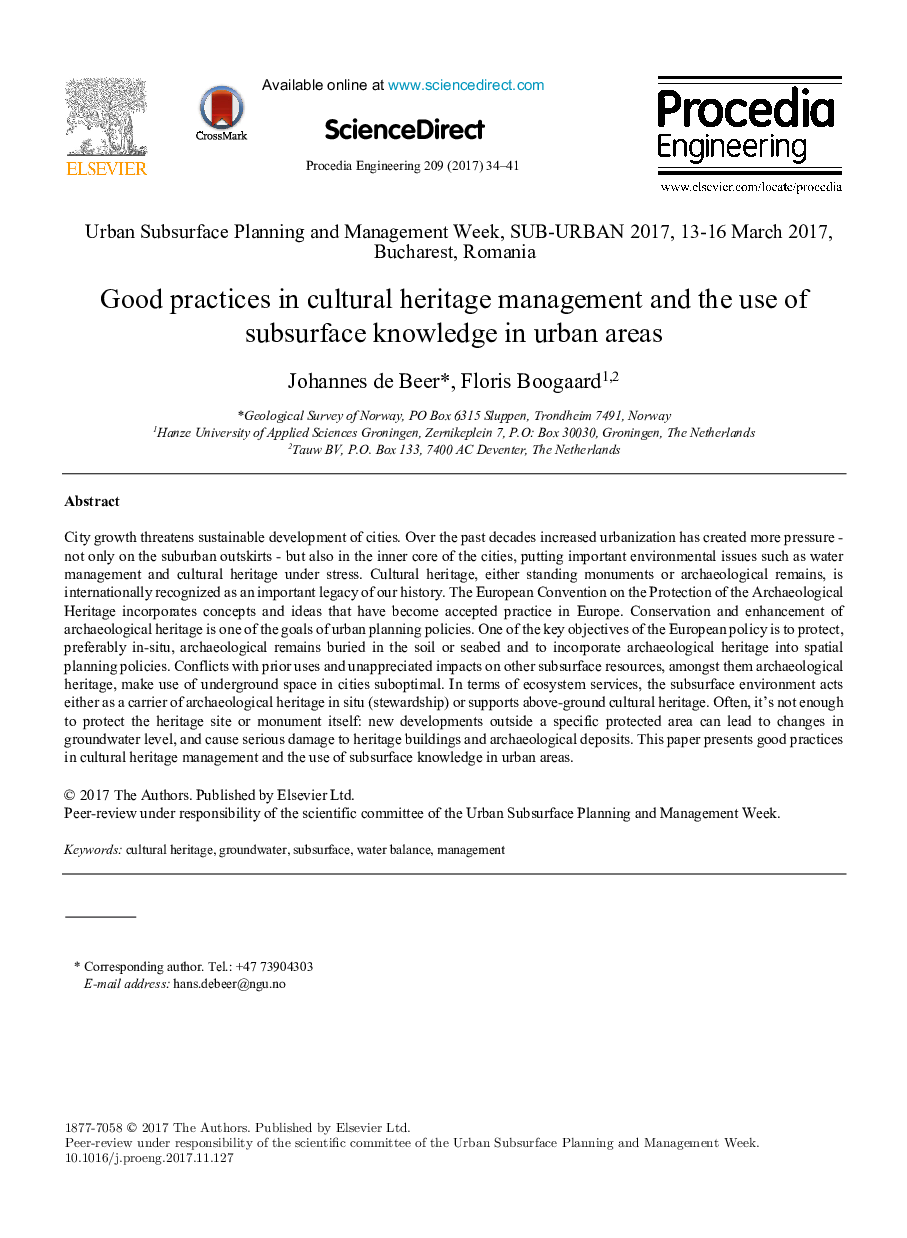| کد مقاله | کد نشریه | سال انتشار | مقاله انگلیسی | نسخه تمام متن |
|---|---|---|---|---|
| 7226897 | 1470617 | 2017 | 8 صفحه PDF | دانلود رایگان |
عنوان انگلیسی مقاله ISI
Good practices in cultural heritage management and the use of subsurface knowledge in urban areas
ترجمه فارسی عنوان
شیوه های خوب در مدیریت میراث فرهنگی و استفاده از دانش زیرزمینی در مناطق شهری
دانلود مقاله + سفارش ترجمه
دانلود مقاله ISI انگلیسی
رایگان برای ایرانیان
کلمات کلیدی
میراث فرهنگی، آبهای زیرزمینی، زیر زمین، تعادل آب مدیریت،
ترجمه چکیده
رشد شهر، توسعه پایدار شهرها را تهدید می کند. طی دهه های گذشته، شهرنشینی افزایش یافته است، نه تنها در حومه حومه، بلکه در مرکز هسته ای شهر، فشارهای مهمی بر محیط زیست مانند مدیریت آب و میراث فرهنگی ایجاد کرده است. میراث فرهنگی، یا آثار تاریخی و یا باقی مانده های باستان شناسی، در بین المللی به عنوان یک میراث مهم تاریخ ما شناخته شده است. کنوانسیون اروپا در مورد حفاظت از میراث باستان شناسی شامل مفاهیم و ایده هایی است که در اروپا پذیرفته شده است. حفاظت و ارتقاء میراث باستان شناسی یکی از اهداف سیاست های برنامه ریزی شهری است. یکی از اهداف کلیدی سیاست اروپا حفاظت، ترجیحا در محل، باقی مانده های باستان شناسی در خاک یا بستر درختان و حفظ میراث باستان شناسی به سیاست های برنامه ریزی فضایی است. تعارض با استفاده های پیشین و تأثیرات نامطلوب بر روی دیگر منابع زیرزمینی، در میان آنها میراث باستان شناسی، از فضای زیرزمینی در شهرهای غیرپتیلامال استفاده می کنند. با توجه به خدمات اکوسیستم، محیط زیرزمینی یا به عنوان حامل میراث باستان شناسی در محل (نظارت) عمل می کند یا از میراث فرهنگی زمینی حمایت می کند. اغلب به اندازه کافی برای محافظت از سایت میراث یا بنای خود کافی نیست: پیشرفت های جدید در خارج از یک منطقه حفاظت شده خاص می تواند منجر به تغییر در سطح آب های زیرزمینی شود و باعث آسیب جدی به ساختمان های میراث و ذخایر باستان شناسی شود. این مقاله شیوه های خوبی در مدیریت میراث فرهنگی و استفاده از دانش زیرزمینی در مناطق شهری ارائه می دهد.
موضوعات مرتبط
مهندسی و علوم پایه
سایر رشته های مهندسی
مهندسی (عمومی)
چکیده انگلیسی
City growth threatens sustainable development of cities. Over the past decades increased urbanization has created more pressure - not only on the suburban outskirts - but also in the inner core of the cities, putting important environmental issues such as water management and cultural heritage under stress. Cultural heritage, either standing monuments or archaeological remains, is internationally recognized as an important legacy of our history. The European Convention on the Protection of the Archaeological Heritage incorporates concepts and ideas that have become accepted practice in Europe. Conservation and enhancement of archaeological heritage is one of the goals of urban planning policies. One of the key objectives of the European policy is to protect, preferably in-situ, archaeological remains buried in the soil or seabed and to incorporate archaeological heritage into spatial planning policies. Conflicts with prior uses and unappreciated impacts on other subsurface resources, amongst them archaeological heritage, make use of underground space in cities suboptimal. In terms of ecosystem services, the subsurface environment acts either as a carrier of archaeological heritage in situ (stewardship) or supports above-ground cultural heritage. Often, it's not enough to protect the heritage site or monument itself: new developments outside a specific protected area can lead to changes in groundwater level, and cause serious damage to heritage buildings and archaeological deposits. This paper presents good practices in cultural heritage management and the use of subsurface knowledge in urban areas.
ناشر
Database: Elsevier - ScienceDirect (ساینس دایرکت)
Journal: Procedia Engineering - Volume 209, 2017, Pages 34-41
Journal: Procedia Engineering - Volume 209, 2017, Pages 34-41
نویسندگان
Johannes de Beer, Floris Boogaard,
